组内消息
2023-01-20
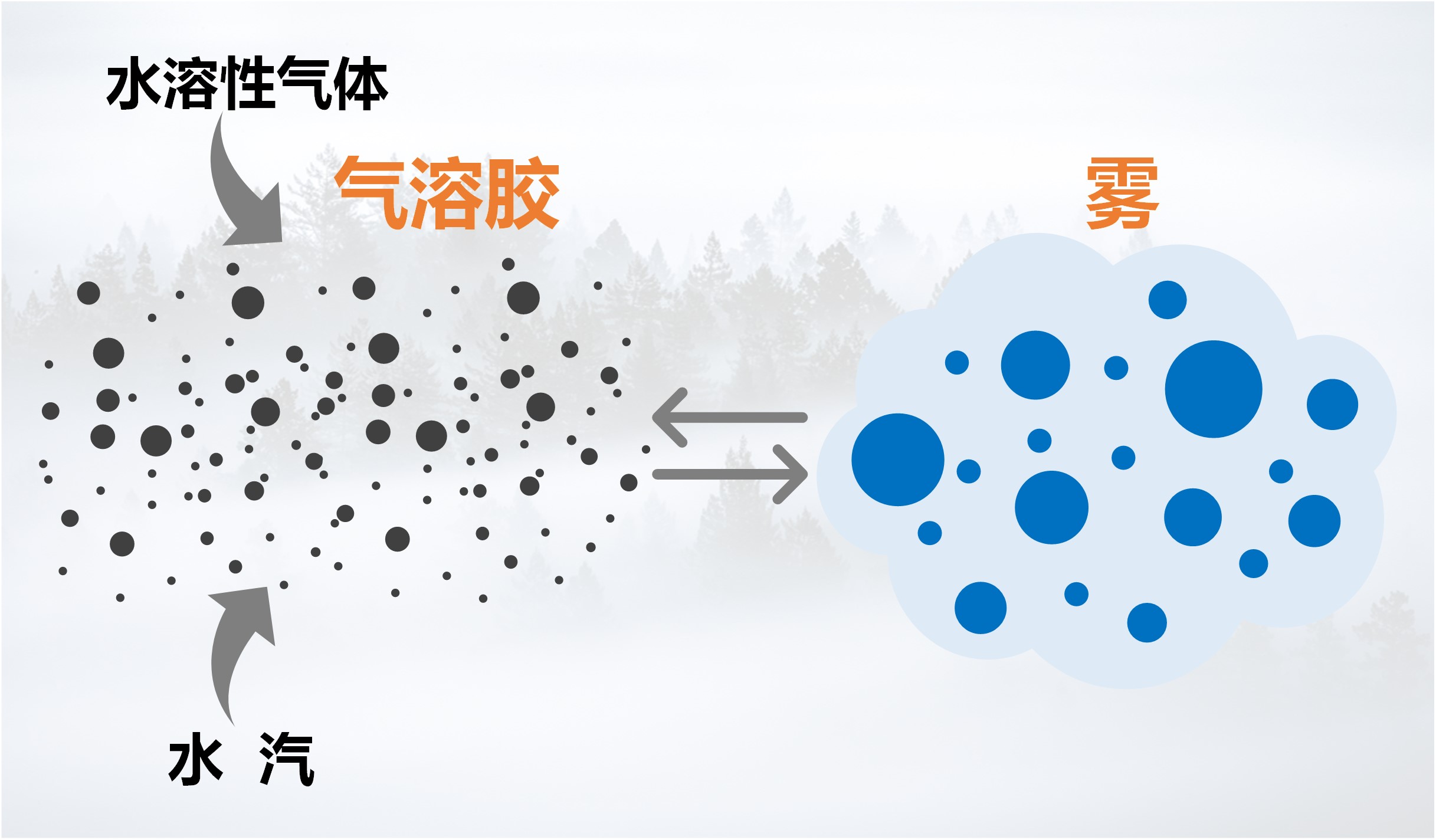
在我国秋冬季节,雾霾事件时有发生。二次有机气溶胶(SOA)对雾霾有重要贡献,然而SOA与雾(或云)之间的基本相互作用还知之甚少,主要原因包括:(1)与无机盐不同,SOA主要由半挥发或中等挥发的有机气体通过气-粒转化形成,这意味着SOA的吸湿性(或活化为云雾滴的能力)不仅取决于颗粒态有机分子,同时还受SOA气态前体物的影响;(2)SOA组成和形成机理的复杂性,SOA由成千上万种有机分子组成,其来源不仅包括各种气相反应,而且还包含了大量颗粒相反应;(3)外场观测中通常采用热力学模型(例如,ISORROPIA或E-AIM)估算颗粒水含量,但其往往忽视了有机气溶胶对颗粒水的贡献;(4)要揭示SOA-雾相互作用,还需要精细化的气溶胶动力学模式与云雾微物理过程进行耦合,而在线耦合数千反应和数百个物种的大气化学动力学过程与云雾的微物理过程是一项挑战性任务。
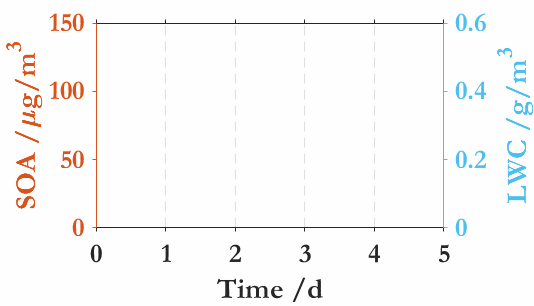
中国科学院大气物理研究所贾龙副研究员及其合作者(徐永福和段民征研究员)通过高分辨质谱技术和精细化的气溶胶动力学模式(CSVA),在深入解析甲苯气态和颗粒态分子的基础上,从云雾微物理角度解析了SOA与云雾之间的相互作用,并首次发现气溶胶-雾相互作用是导致的SOA爆发性增长的关键机制。即,霾(haze)与雾(fog)紧密交织在一起,一方面,水溶性气态有机物的存在会降低SOA活化为云雾滴的临界过饱和比,导致SOA在湿度接近或低于100%时即可活化为云雾滴;同时,云雾的生成进一步促进水溶性气态有机物的气-粒转化,从而导致了SOA的爆发式增长。还进一步分析了温度和相对湿度在SOA生成中的协同作用,发现低温可以显著放大有机气体对SOA爆发式增长和云凝结核活化的作用。上述结果表明云雾微物理过程是水溶性气态有机物快速转化为二次有机气溶胶的主要原因。
Jia, L., Xu, Y., Duan, M., 2023. Explosive formation of secondary organic aerosol due to aerosol-fog interactions. Sci. Total Environ. 866, 161338. https://doi.org/10.1016/j.scitotenv.2022.161338
组内消息
2022-07-01
苯乙烯是城市大气中二次有机气溶胶(SOA)的重要前体物。由于苯乙烯具有芳香烃和烯烃的双重属性,因此作为一种重要的基础化工原料被广泛用于合成树脂和橡胶,从而导致苯乙烯具有广泛的人为排放源。以往研究发现苯乙烯具有很高的SOA生成潜势,但是缺少对苯乙烯SOA化学组成的了解。
最近,中国科学院大气物理研究所于姗杉博士和贾龙副研究员等结合自助开发的电离源和轨道阱质谱技术,首次从分子水平揭示了苯乙烯生成的二次有机颗粒物的化学组成(图1)。发现苯乙烯与臭氧反应可以生成一类分子量高达700Da的大分子聚合物。这类聚合物的挥发性极低,一旦在气相生成便可以单独成核。通过解析分子结构,发现Criegee自由基是此类聚合物生成的关键中间物质,并通过实验证实水汽对Criegee聚合反应具有抑制作用。
一般认为气态硫酸是大气中主要的成核物质,不过,实验室关于硫酸成核的研究与外场观测到的现象并不一致。如,外场观测到的成核过程与相对湿度呈负相关性,但实验室研究发现水汽对硫酸成核却具有促进作用。水汽对苯乙烯成核的抑制作用可以很好的解释这一下现象。同时也在外场颗粒物中发现了源自苯乙烯的聚合物,从而证实苯乙烯是大气中潜在的成核物质(图2)。由于苯乙烯在城市地区具有较高的浓度,因此苯乙烯对大气成核的贡献不容忽视。相关结果发表在Chemosphere和 Atmospheric Research上。
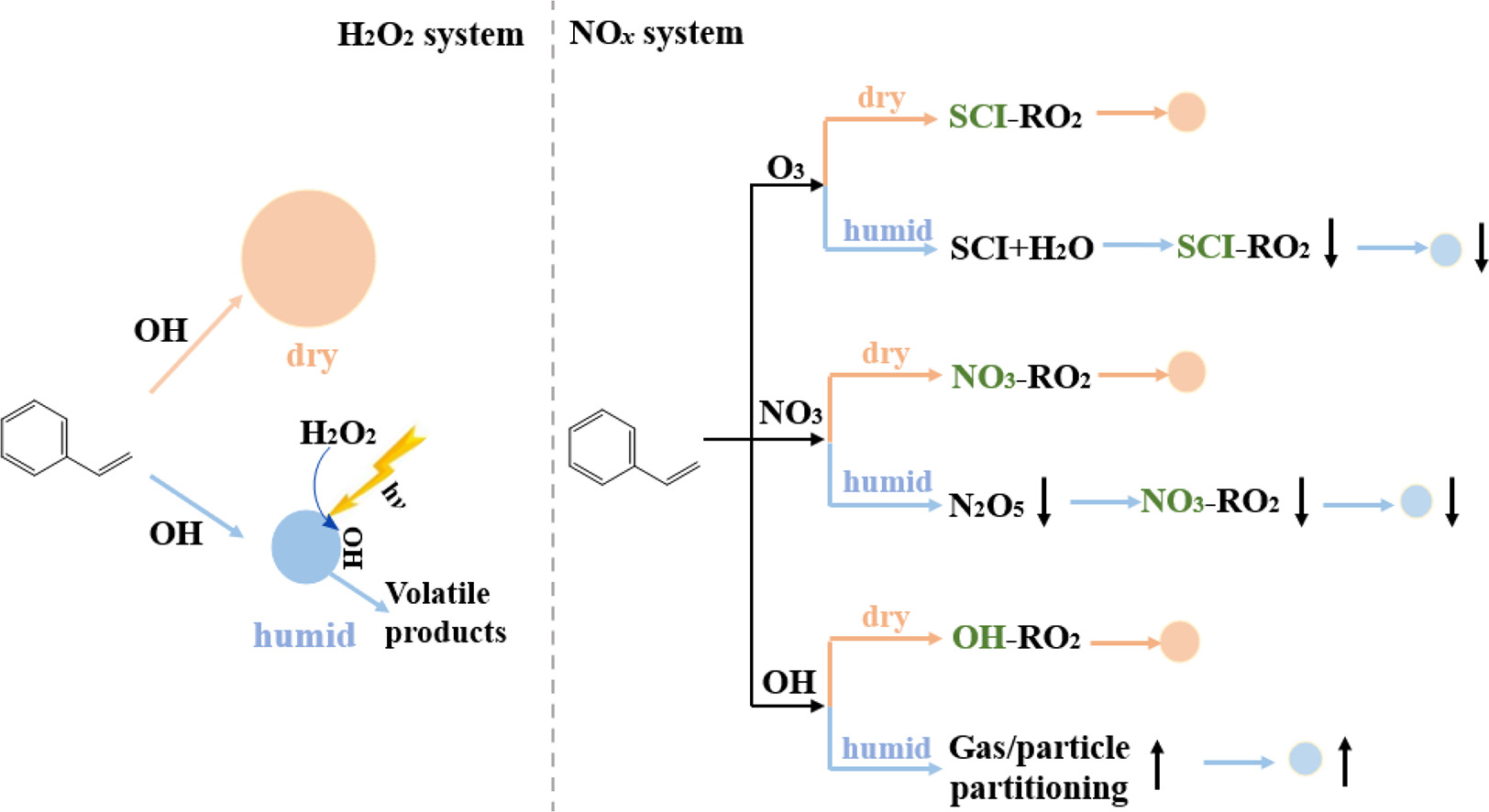
图1 相对湿度对苯乙烯氧化产物的影响机制
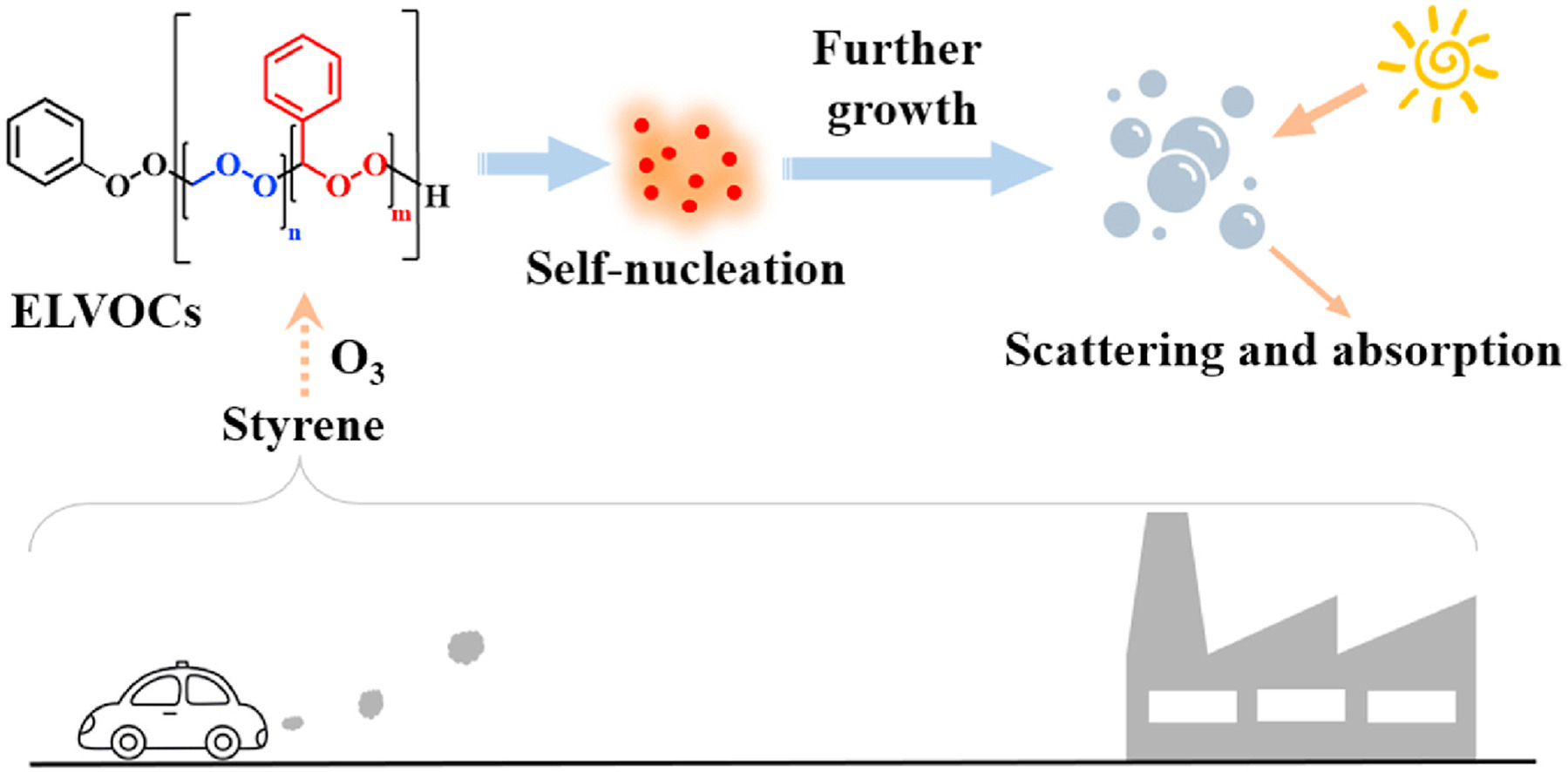
图2 苯乙烯与臭氧反应生成的大分子聚合物是重要的成核物质
Yu, S.S., Jia, L.*, Xu, Y.F., Pan, Y.P., 2022. Formation of extremely low-volatility organic compounds from styrene ozonolysis: Implication for nucleation. Chemosphere 305, 135459. https://doi.org/10.1016/j.chemosphere.2022.135459
Yu, S.S., Jia, L.*, Xu, Y.F., Pan, Y.P., 2022. Molecular composition of secondary organic aerosol from styrene under different NOx and humidity conditions. Atmospheric Research. 266, 105950. https://doi.org/10.1016/j.atmosres.2021.105950
组内消息
2021-06-11
二次有机气溶胶(SOA)是大气细颗粒物(PM2.5)的重要组分,对能见度和人体健康等有重要影响,在空气污染和全球气候变化中起着关键作用。SOA主要由挥发性有机物(VOC)的降解产物通过气-粒转化生成,其化学成分非常复杂,分子组成往往可达千种。目前SOA演化机制的不确定性,直接制约了正确评估气溶胶对区域空气质量乃至全球气候的贡献影响,因而准确模拟SOA的生成和演化成为全球特别是我国所面临的重要的前沿科学问题。
中科院大气所徐永福课题组通过光化学烟雾箱实验对不同有机物氧化生成SOA的条件和化学反应机制进行了深入研究,如确定了小分子有机物生成SOA的条件和机理,确定了湿度在芳香烃和萜烯类物质生成SOA中的不同作用等。近年来,虽然国内外研究者在SOA成核、传质和老化等方面取得了很多进展,但由于缺乏一种化学动力学模式对各个过程进行耦合和评估,从而导致对SOA的认识存在碎片化的问题。
为了全面了解SOA的生成和演化规律,最近贾龙和徐永福开发了一种基于黏度的二次有机气溶胶核-壳动力学模式(CSVA)。该模式依气溶胶的分子组成将单个颗粒分为核壳两部分,并通过单一方程描述了气-粒转化涉及的气相扩散、界面传质和颗粒相扩散过程(图1),最终用化学反应动力学类似的方程对成核、传质和老化过程进行描述(图2)。烟雾箱实验表明,CSVA可以很好地捕捉以下过程:(1)依赖于湿度的H2SO4-NH3-H2O酸碱成核过程;(2)依赖于颗粒物粒径的无机和有机气溶胶吸湿动力学过程;(3)相对湿度对SOA生成的作用;(4)基于黏度的气溶胶粒径分布特征,等。此外,CSVA模式首次阐明了为什么SOA粒子会由单峰模态演变为双峰模态(图3)的内在机制。
目前国际上仅有个别基于黏度的SOA气-粒传质模型,此类模型假定SOA颗粒为多层和双层结构。这类层结构模型需要耦合各层之间的传质过程,因此极大地增加了模拟复杂度。与之相比,CSVA的结构更清晰和简洁、计算效率更高。这使得CSVA有潜力与其他空气质量模式进行耦合,从而对不同的大气条件下气溶胶演化进行准确模拟。该工作已经在Science of the Total Environment发表。
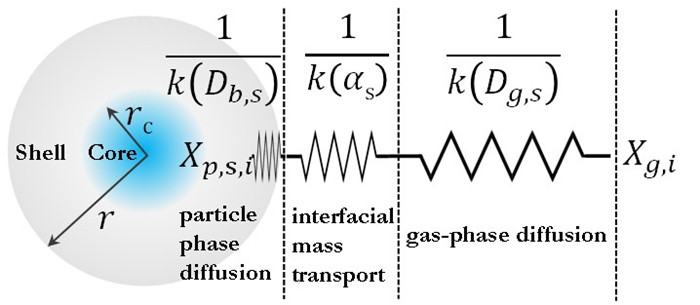
图1. 核-壳结构的单颗粒SOA的传质示意图
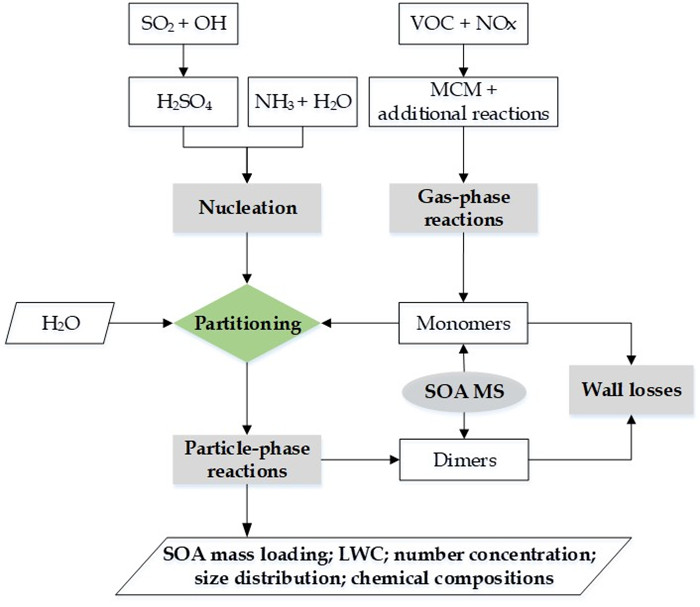
图2. CSVA模式的整体框架
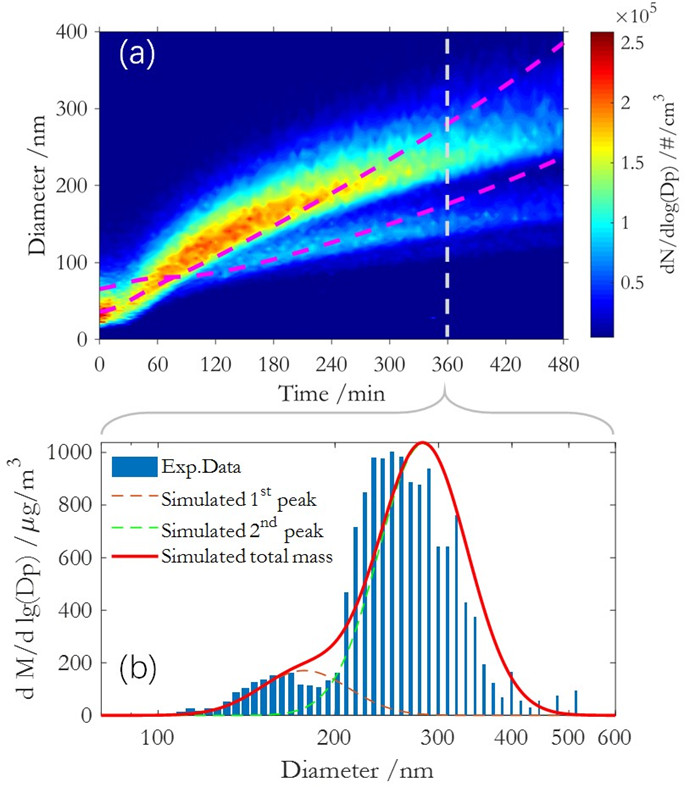
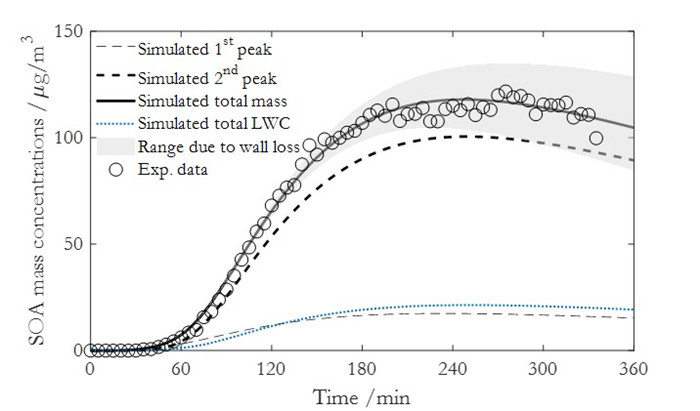
图3.CSVA模拟结果与烟雾箱实验值的比较
Jia, L., Xu, Y.F.*, 2021. A core-shell box model for simulating viscosity dependent secondary organic aerosol (CSVA) and its application. Sci. Total Environ. 789, 147954. https://doi.org/10.1016/j.scitotenv.2021.147954
Jia, L., Xu, Y.F.*, 2020. The role of functional groups in the understanding of secondary organic aerosol formation mechanism from α-pinene. Sci. Total Environ. 738, 139831. https://doi.org/10.1016/j.scitotenv.2020.139831
Zhang, Q., Xu, Y.F.*, Jia, L., 2019. Secondary organic aerosol formation from OH-initiated oxidation of m-xylene: effects of relative humidity on yield and chemical composition. Atmos. Chem. Phys. 19, 15007–15021. https://doi.org/10.5194/acp-19-15007-2019
Jia, L., Xu, Y.F.*, 2018. Different roles of water in secondary organic aerosol formation from toluene and isoprene. Atmos. Chem. Phys. 18, 8137–8154. https://doi.org/10.5194/acp-18-8137-2018
Ge, S.S., Xu, Y.F.*, Jia, L., 2017. Secondary organic aerosol formation from propylene irradiations in a chamber study. Atmos. Environ. 157, 146–155. https://doi.org/10.1016/j.atmosenv.2017.03.019
- « PREV
- 1
- 2
- 3
- 4
- 5
- ...
- 9
- NEXT »












